Menus
- Big bikes from the 70s
- BMW R 90 S (1973-1976)
- Kawasaki 900 Z1 (1972-1976)
- Laverda 1000 3C (1973-1978)
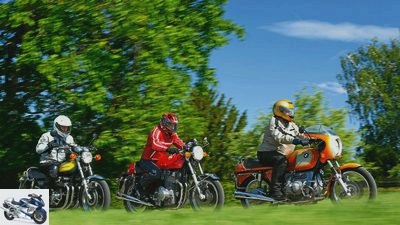

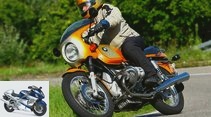
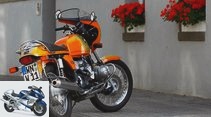
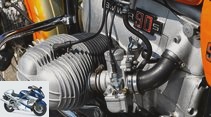
30th photos
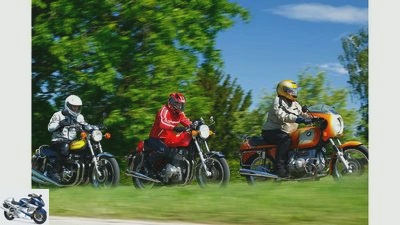
1/30
Big bike classics from the 70s – pure fascination. Kawasaki 900 Z1, Laverda 1000 3C and BMW R 90 S driven by MOTORRAD Classic.
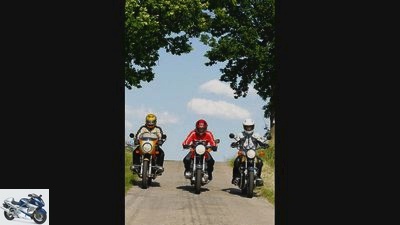
2/30
BMW R 90 S, Laverda 1000 3C and Kawasaki 900 Z1.
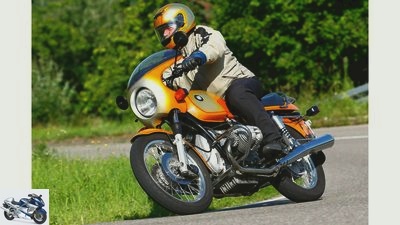
3/30
Fast cornering with the BMW R 90 S..
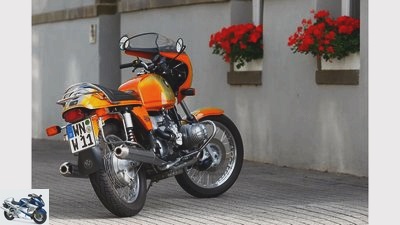
4/30
BMW R 90 S..
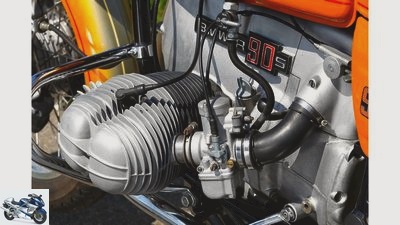
5/30
Boxer engine of the BMW R 90 S..

6/30
The R 90 S-Boxer: with a reinforced engine housing, still without a central crankshaft bearing.
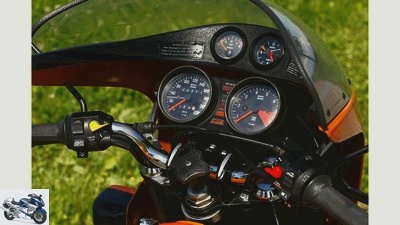
7/30
Well ahead in terms of equipment: the Moto Meter cockpit with numerous lights and displays.

8/30
Anyone who decelerates in good time before the curve with the effective swivel caliper brakes can drive a clean and brisk line around the curve while pulling.
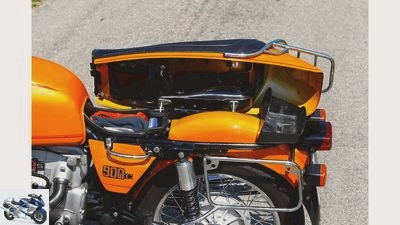
9/30
Foldable bench with storage compartment and compartment for a wide range of tools.
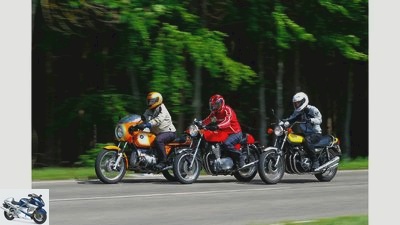
fact
10/30
BMW R 90 S, Laverda 1000 3C and Kawasaki 900 Z1.
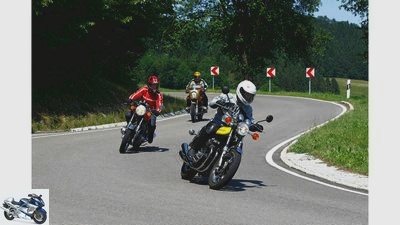
11/30
Each of the three bikes requires its own tactic when cornering quickly.
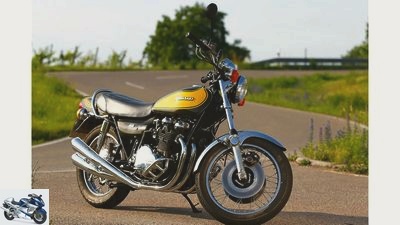
12/30
Kawasaki 900 Z1.
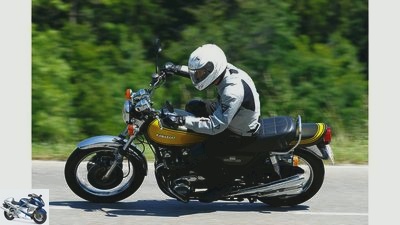
13/30
If you trust the grip, you will eventually touch the side stand arm.
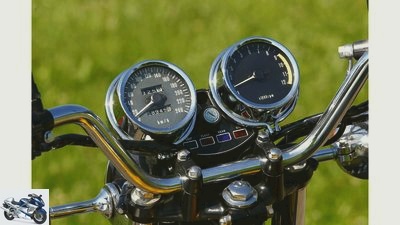
14/30
It couldn’t be more classic: chrome-plated round clocks, egg cups, a couple of lights – done.
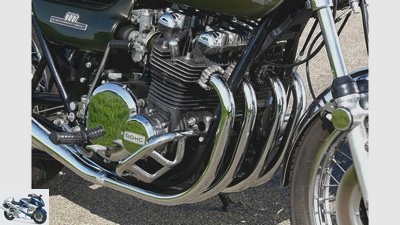
15/30
Engine and manifold of the Kawasaki 900 Z1.
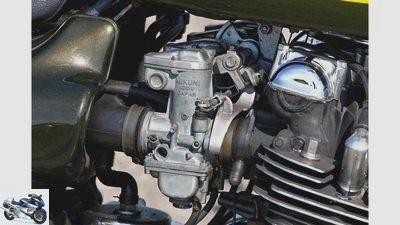
16/30
The 28 mm Mikuni carburettors ensure a smooth response to the gas and also look good.
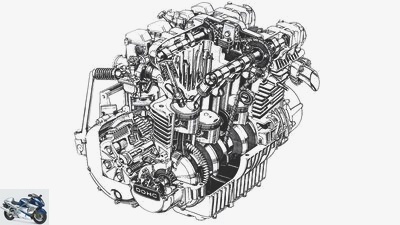
17/30
The dohc four-cylinder also cuts a fine figure on its own, i.e. without a Z1 around it.
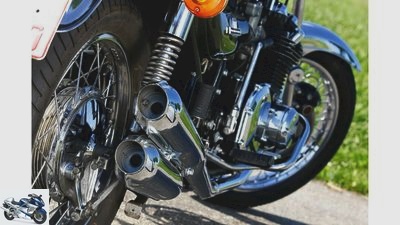
18/30
In 1973 practically everyone who was on two wheels looked into this striking four-pipe exhaust system.
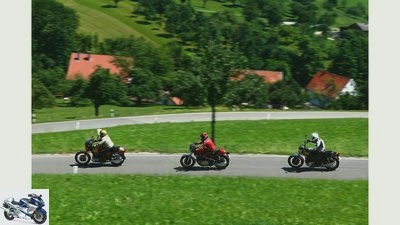
19/30
Three powerful engines send an impressive soundscape down into the valley.
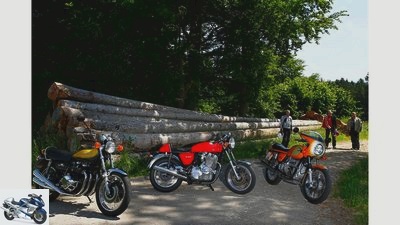
20/30
The big engines all have a lot of wood in front of the hut, they don’t burn anything in terms of performance.
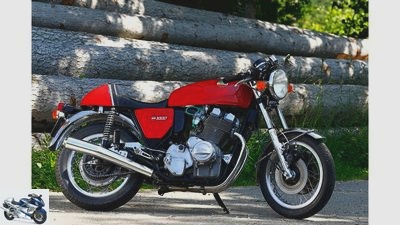
21/30
Laverda 1000 3C.
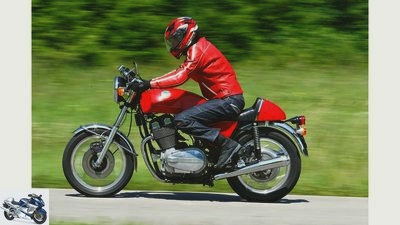
fact
22/30
Without further ado: The sitting posture on the Laverda is in nature much more strenuous than it appears in the picture.
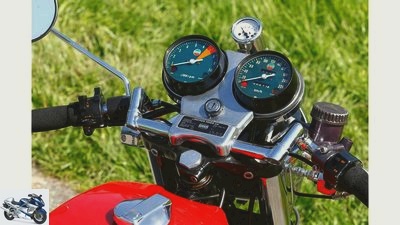
23/30
The Nippon Denso instruments were the best you could get back then.
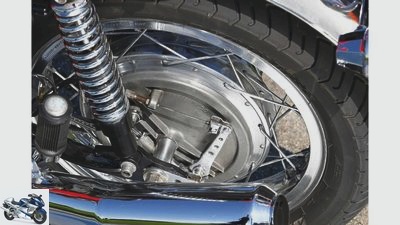
24/30
Drum brake, the measure of all things back then.
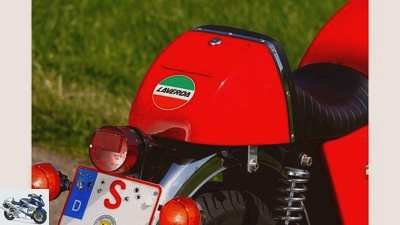
25/30
The pretty hump seat is not standard on the 1000 3C, it comes from the 750 SF and is padded.
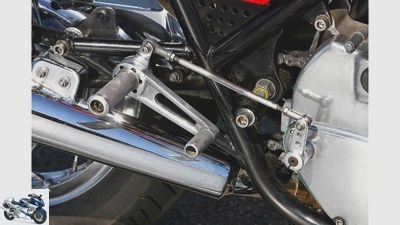
26/30
The retrofitted footrest system of the 1000 Jota.
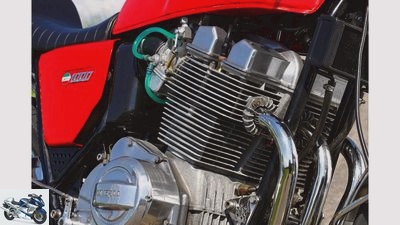
27/30
Motor of the Laverda 1000 3C.
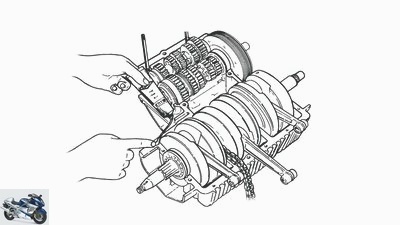
28/30
Insight into the inner workings of a triplet with a 180-degree crankshaft.
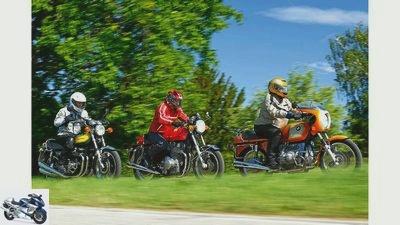
29/30
BMW R 90 S, Laverda 1000 3C and Kawasaki 900 Z1.
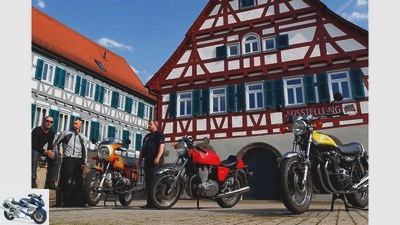
30/30
This trio of classics also celebrates breaks with style.
BMW R 90 S, Kawasaki 900 Z1 and Laverda 1000 3C on the move
Big bikes from the 70s
Content of
Anyone who was into killer performance bikes in the early 70s probably dreamed of one of these three bikes. All three already fascinated with their powerful acceleration and distinctive sound – and they still do it today.
L.Achievement and money have something in common: neither makes you happy, but it is extremely calming. Well, all of us who have caught the classic bug know that driving pleasure and excitement do not depend on performance. And yet, now as then, it exerts a very special attraction, stimulating peak values and possible speeds. That was of course also the case in the early 1970s, when the performance spiral was turning ever faster. Production motorcycles that scratched the 80 hp mark and tried their hand at the magical 200 km / h sound barrier – madness at the time! Representatives from very different camps and from different nations outbid each other in announcing milestones, and they should all be right in their own way.
And now three of these milestones are waiting for us with the BMW R 90 S, the Kawasaki 900 Z1 and the Laverda 1000 3C, wanting to seduce us once again to take a trip into the past. So here German thoroughness against Italian race and Japanese superlatives – three world views, three camps of two-wheeled fans that seldom allowed overlap. And yet all three superbikes of the early 1970s followed the same development goal – high engine performance, sporty chassis and a corresponding image. The author, at that time still in elementary school age, snuck around regularly at the annual motocross race. Not around the paddock or even around the terribly dusty or mercilessly muddy track, but across the parking lots and the adjacent side streets to admire the parked bikes of the visitors, among which, after persistent searches, some rarities and spectacular novelties could always be discovered. And it was there that the first awesome encounters with the Kawasaki Z1 and later with the R 90 S also took place. Back then, the Kawasaki was a goddess on wheels, terribly strong, terribly fast, and with its two-tone paintwork and the very long seat back, it was beguilingly beautiful. The author, who was still dreaming of a driver’s license at the time, found a BMW quite attractive for the first time. Because the R 90 S looked sporty and not as conservative as the “normal” boxer bikes. Laverdas? Also existed. Rare. Exotics that you couldn’t see anywhere else over the year. And today? Are we just lucky that our colleague Harry Humke gives us his Laverda 1000 3C, as does Peter Krauss, President of the Z-Club Germany, a Kawasaki Z1. Hans-Peter Krause completes the trio with his superbly restored R 90 S, who simply wants to take a ride.
Fast cornering with the BMW R 90 S..
BMW R 90 S – The Boxer
Off we go, first on the BMW: The Bavarian with the tried and tested, but in many ways further developed, two-cylinder boxer was already the top model of the new / 6-series as part of the celebrations for the 50th birthday of the BMW motorcycle presented, but the version shown here is a 1976 model that was completely rebuilt a few years ago. The paintwork in Daytona Orange and the perforated brake discs did not find their way into the R 90 S until 1975. Right from the start, from 1973 onwards, the bore, which was 90 by eight millimeters larger than in the R 75/5 engine, ensured the image-boosting displacement of 898 cm³ and contributed to the correspondingly rich torque of 75 Nm at a moderate 5500 rpm. But because the top performance had to be right in order to crack the targeted 200 km / h wall, the BMW engineers donated the R 90 S powerful 38 Dellorto carburettors with an accelerator pump. The carburetors were once thought to be responsible for poor cold start behavior, but after pressing the choke lever and pressing the button, the boxer spontaneously comes to life under the hard metal impact of the starter. Short warm-up phase, then the choke can already be released. The engine runs at idle with characteristic shaking, the single-plate dry clutch requires a firm handshake, and the first stage of the new five-speed gearbox engages with a crack. Like a sprinter, the Bavarian lifts her buttocks before moving forward – typically old-school cardan, typically BMW. Anyone who adjusts to the elevator effect, downshifts in good time before bends, engages the clutch sensitively and never takes off the accelerator in bends, which would result in spontaneous collapse and possible touchdown, will make good progress with the BMW.
As you get used to it, gear changes become smoother and smoother, and the strained left hand alone hurts after several kilometers. It’s good that the elastic boxer does not force the driver to do any unnecessary gearshift work, after all, the 900er works just as smoothly as it is emphatic, even at low engine speeds. The two-valve engine has its strengths above all in the middle speed range, even if it begins to vibrate a little more noticeably at around 5500 tours. At the latest from 6000 rpm, however, the revving ability decreases, the region over 7000 tours near the red area is better avoided out of consideration for the antiquated valve train with its long bumpers. The 200 km / h that can theoretically be achieved at 7400 rpm remain theory today. She could if she wanted to. Perhaps. But the former ambition is actually no longer of interest today. Rather, what counts is the pleasure of hearing the boxer grumble, enjoying the amazingly comfortable sitting posture on the flat bench, which is better padded than it initially appears. Incidentally, the Bavarian woman is easier to steer with the narrow handlebars than initially thought, and the handlebar-fixed fairing actually offers noticeable wind protection. However, as noted in early tests, it is probably responsible for the slight restlessness that sets in at higher speeds. Apparently, the BMW is light up front, which should also explain why the S is more stable with heavy drivers than with lightweights.
This trio of classics also celebrates breaks with style.
After all, the pretty shell also makes for a superlative: the R 90 S can claim to be the first bike in the world with standard handlebar fairing, which continued to house a headlight with H4 light for the first time. In general, the top model impresses with its lavish equipment, such as extensive displays in the cockpit, rich, high-quality tools under the foldable bench seat, where there is also an additional, practical storage compartment, and spring struts that can be adjusted using a hand lever. Speaking of spring elements: The attractive fork and the overall soft design of the suspension guarantee great driving comfort for relaxed, fatigue-free driving even after hours.
The other side of the coin, however, turns out to be the strong diving movement of the front. The fork even hits the stop when braking. This may be comfortable, but for ambitious sport you would want a tighter set-up. You probably heard this often in Munich at the time, because from the end of 1974 there were dampers with a harder compression stage for the fork. On the other hand, nothing has changed in the unconventional combination of cable and hydraulic actuation of the front brake. Because they didn’t want the weight of the brake fluid reservoir on the handlebars, a Bowden cable led from the hand lever to the master brake cylinder under the tank, and from there the hydraulic lines to the brake calipers. There isn’t much to complain about when it comes to the effect of the brakes if you take a bold step. Of course, modern systems have a much more toxic effect, they are easier to dose and, in contrast to the R 90 S system, provide a clear pressure point. But what modern motorcycle has so much unique design and sporty elegance to offer?
If you trust the grip, you will eventually touch the side stand arm of the Z1.
The four: Kawasaki 900 Z1
With the “almost 40s”, however, you don’t have to look far. With such attributes, the Kawasaki spontaneously comes to the fore. Unmistakable, beautiful design, coupled with the claim to set the bar highest for superbikes – that made the Z1 a legend back then. It is difficult to understand why it was called Frankenstein’s daughter shortly after its appearance with the nickname Frankenstein’s daughter, which is still attached to it today, since it is ready to go in full splendor. Well, at that time a brutal 79 hp from exactly 903 cm³ of displacement hit an overstrained chassis, according to some testers. But was that really as dramatic as reported back then? How does that feel from today’s perspective? Decades later, a secret dream will mercilessly burst and give way to disillusionment?
The yellow-green Z1 shines happily in the blazing sun. It is a 73 model, but with the sensibly retrofitted double disc of the 1976 Z 900. The high “deer antler handlebar” does not exude pure, sporty flair at first glance, but this is exactly how it was in 1972, at least for the amazed, mostly enthusiastic Audience presented. At this point the whole action had a long history. In 1967, engineer Inamura had already received the order to develop a large four-stroke four-cylinder. Just one year later, the 750cc engine was successfully on the test bench. But then, in the fall of 1968, competitor Honda came out completely unexpectedly, almost like Kai out of the box, with the sensation and presented the astonished world with the CB 750 Four. Kawasaki had to counter without copying and was forced to act. It was supposed to be the strongest and fastest production bike, so the displacement grew to around 900 cm³.
At the IFMA 1972 in Cologne, the then Kawasaki importer Detlev Louis presented the Z1 – the enthusiasm was overwhelming. Already in the first year of sales, 2500 copies at a price of 7200 marks found their buyers, the spread of the now legendary Z could not be stopped. The Z1, which weighs 246 kilograms with a full tank, feels lighter when you sit on it, and the pounds seem well distributed. With the wide and high handlebars, the 900 can be easily pushed and maneuvered. In contrast to the comparatively antiquated valve control of the BMW using a camshaft located below via bumpers and rocker arms, the Kawasaki shows off two overhead camshafts and valve actuation via bucket tappets, its crankshaft rotates in six roller bearings. Four 28 mm Mikuni carburettors prepare the mixture for the four combustion chambers, a choke flap ensures enrichment during a cold start and the four willingly starts work at the push of a button. No shaking, no pounding, hardly any vibrations, there is simply a deep roar that gives an idea of the power that the four-cylinder can release.
The clutch needs little power, the transmission shifts precisely and smoothly, hard to believe that the design is four decades old. The four-cylinder takes off silky smoothly from 1500 rpm, increases evenly in performance, without being strained or annoying with vibrations. Well, with around 5000 tours it tingles a little, somewhere between 6000 and 7000 rpm the bride finally unpacks the club. Now at the latest it becomes clear what once brought you the reputation of the murderously gripping brutal bike. Manually stopped 3.7 seconds from 0 to 100 km / h and a top speed of 211 km / h were fabulous values at that time, which can still be seen today.
The big engines all have a lot of wood in front of the hut, they don’t burn anything in terms of performance.
The sound from the four-in-four system is also one of the most intoxicating sound experiences. If the hairs on the neck do not stand up, you have to be deaf. Despite all the wildness and the rough charm that the Z1 exudes, it still retains manners. Throttle response and load changes are smooth and without jerking, simply “smooth”. The spring elements of the 900s are not quite as obliging. Although not unbearably hard as a board, the fork in particular passes on short, dry bumps quite unabashedly, it only remembers its task when the waves are rough. The series suspension struts at the rear, which caused significant unrest in the rear when driving at a brisk ride on an undulating surface, replaced almost all Z1 owners with tighter cones as quickly as possible. If, as with this example, the second disc was retrofitted at the front, which was only standard from model year 1976 onwards, brisk rides with heavy braking maneuvers before bends can be completed with pleasure and without fear. Ultimately, the filigree-looking, but at least five quintals heavy Z1 proves to be nimble and agile like a 200-kilo bike, is neither wobbly nor burdened with erecting moment – the narrow-tyred Kawa is really fun on winding passages. With the wide handlebars you can circle corners completely relaxed, the upright, relaxed posture, together with the only moderately bent legs, make longer stays in the saddle extremely bearable.
On hot days like today, however, the air-cooled four-cylinder seems to be gasping for oxygen, or why does the four-man suddenly pull with increasing reluctance and grumbling, catching itself up again, only to stutter again? About lack of fuel? Now? The relatively modest tank capacity of 16.5 liters seems to be running out. In view of the test consumption of 8.5 liters / 100 km that was once measured, the range is actually modest. So switch to reserve and roll over to the gas station in the next town, who knows how far the reserve will go. Fetching fuel can’t hurt anyway, and the Laverda’s well-formed fuel barrel should soon be empty. After all, their three-cylinder is not a food lover, as they say.
Without further ado: The sitting posture on the Laverda is in nature much more strenuous than it appears in the picture.
The triple: Laverda 1000 3C
When you switch from the Z1 to the Laverda, fun is over anyway. Compared to the hard 1000 3C with the sitting posture stretched out over the long tank, the Kawa practically goes through as a tourer. But fans of the Italian brand and their uncompromising bikes know this and love this attitude: motorcycles for men – tough but honest. The new three-cylinder bike was shown for the first time as the Laverda 1000 at the Milan Salon in 1971, and only at the IFMA 1972 in Germany. Harry’s copy is an early 1000 3C from the end of 1973, with a Brembo double disc brake instead of the drum brake of the first edition.
The recently revised engine comes from a 1975 machine, so it already has the oil cooler installed from April 1974, which, given the modest oil volume of only 3.1 liters, appears to be urgently needed. Not everything is standard on Harry’s machine and certainly not original, but which Laverda it ever was?
There were actually blasphemers who claimed that in Breganze “what was currently available was installed” simply because small improvements simply flowed seamlessly and undocumented into production. As a rule, however, the parts were of high quality, such as the Nippon Denso instruments, Ceriani forks or Bosch ignitions. Harry’s 1000, the rear light and the hump seat of the 750 SF as well as the footrests of the later Jota are good. The latter do little to change the rather sporty sitting posture with strongly bent legs and elongated arms that have to be stretched to the adjustable sports handlebars. When stationary and when maneuvering, the 243 kilos of the Laverda feel as heavy as lead, the mighty, tall three-cylinder drives the center of gravity upwards. The impression is put into perspective when driving. Assuming she drives first. The day had started with problems and poured grist on the mill of the blasphemers: The Laverda stopped already when driving through the first photo curve for the third time. Worried looks, what’s going on? Interconnected, stalled? Not Stefan. He’s an experienced old hand. Clear case, the defect devil has struck.
Some had feared it, pessimists prophesied. Should the joint exit really fail that early? Italians were and still are considered the advocates of German reliability or Japanese perfection as the divas among two-wheelers. Bitchy, moody, unpredictable and sometimes adventurously constructed. Bella macchina. Yes, when things go well. Hold on, we won’t break the staff over the Laverda that quickly. Because the downtime is only due to a defective main fuse, replacement fuses are provided by the tank. But the next one also immediately blesses the temporal. Ground contact? Short circuit? An obvious bare spot cannot be seen. Stefan remembers blinking and pressing the switches when turning. Is the worm in here? So Stefan, stay away from the indicators and other switches. Lo and behold: the Laverda holds out the rest of the day. Good steed.
Now, in the late afternoon, change the vehicle. The triple only needed the choke, located at the front left under the tank, this morning, and only briefly, but had been given a short warm-up phase. A twist on the gas – the expected, typical three-cylinder hissing, which sounds so wonderfully like an air-cooled Porsche boxer, does not want to occur. Not even at higher speeds. Can’t at all, because the early Laverda 1000s (up to 1982) still have the 180-degree crankshaft – the crank pin of the middle cylinder works with the aforementioned offset to the two outer cylinders. The sound cannot be assigned correctly right away, passers-by tend to guess a large-volume row twin, but with a slightly more rounded barrel and not really suitable high-frequency singing. In any case, it sounds huge, this monument from an engine.
Each of the three bikes requires its own tactic when cornering quickly.
The slides of the three 32 mm Dellorto carburettors also want to be opened with gentle force. Feels like a joker has hung a ten-pound weight on the throttle cable. To compensate for this, the clutch also requires a strong paw – you still have to work properly on the Laverda. As a reward, the three-of-a-kind pushes the throttle with soulful throttle (if you tear open, you get an indignant slap) with the power that is worthy of a 1000 three-cylinder. Despite the relatively long first gear, which reaches up to 80 km / h, the 3C can be set in motion stress-free with careful use of the throttle and clutch; the gears engage safely and smoothly, provided the pilot takes his time and shifts carefully. The gradation shows a jump between second and third gear that is clearly too big, which the powerful three-cylinder admittedly gallantly overcomes. The shift is on the right, by the way, the rethinking initially requires a little concentration.
BMW R 90 S (1973-1976)
BMW R 90 S..
Price 1973: 8,510 marks
Data (type R 90 S)
engine:
Air-cooled two-cylinder four-stroke boxer engine, an underneath camshaft, two valves per cylinder, operated via bumpers and rocker arms, displacement 898 cm³, output 49 kW (67 hp) at 7000 / min, max. Torque 76 Nm at 5500 rpm
Power transmission:
Single-disc dry clutch, five-speed gearbox, cardan drive
landing gear:
Double loop frame made of tubular steel, telescopic fork at the front, Ø 36 mm, two-arm swing arm, two spring struts, tires 3.25 H 19 at the front, 4.00 H 18 at the rear, double disc brake at the front, Ø 260 mm, swiveling calipers, drum brake at the rear
Measurements and weight:
Wheelbase 1465 mm, weight with a full tank 235 kg
Vmax:
198 km / h
technology
In the wake of the competition among its competitors, the decision was made at BMW, especially at the endeavors of the new board member Bob Lutz, to increase displacement in order to achieve higher, yet stable performance. The boxer offered enough reserves for thicker pistons, so the bore (with the same stroke) grew from 82 to 90 mm, the displacement from 745 to 898 cm³. The cylinder liners of the S model were given a Nikasil coating. The seven HP more power of the S version compared to the basic R 90/6 result primarily from the higher compression (9.5 instead of 9.0: 1) and the use of large 38 Dellorto instead of the usual Bing carburettor. All / 6-series models not only benefit from the new five-speed gearbox, but also from the swing arm, which is five centimeters longer, which reduces cardan reactions. The longer wheelbase also made it possible to install a larger battery. The installation of a more powerful alternator with an output of 280 instead of 180 watts appears to be logical and sensible, if only because of the use of an H4 headlight. As a top model with a top speed of almost 200 km / h, the S was fitted with double disc brakes at the front right from the start, and from 1975 with perforated discs to improve wet braking. The fork, which was initially criticized as being too soft, was tightened over the course of the construction period, and from December 1974 onwards it received dampers with a harder compression stage.
Checkpoints
When viewing a R 90 S, the usual rules apply: Check the engine and drive seals. Oil mist is okay, it is already dripping, it is important to seal it up soon, i.e. every 40 to 50,000 kilometers. A defective shaft seal is very typical, recognizable by the drop from the ventilation slot between the motor and the gearbox. It is also important to clarify whether the engine has already been converted to unleaded petrol (new valve seats). During the test drive you should watch out for swallowing or performance holes, this indicates that the accelerator pumps are not working properly. If you notice oscillating at high speed, this is mostly due to the incorrect setting of the swing arm and / or steering head bearings. If the battery indicator light does not go out even at higher speeds, the alternator has probably given up to the vibrations.
The R 90 S-Boxer: with a reinforced engine housing, still without a central crankshaft bearing.
market
According to BMW, 17 455 copies were sold worldwide. The supply of used vehicles in this country is relatively meager today – most of them have long been in permanent collectors’ hands. It starts at around 5,000 euros, well-groomed specimens are hardly traded for less than 7,000 euros, top treasures for over 10,000 euros.
Specialists
Siebenrock GmbH Telephone 0 7024 / 4688-10 www.siebenrock.com
Q-Tech Telephone 0 57 32/89 17 20 www.q-tech.de
Forums
www.boxer-forum.de
www.powerboxer.de
www.bmw-club.de
history
1976:
Another four millimeters more bore, 980 cm³ and 65, from 1979 70 hp characterize the R 100 S. Instead of spoked wheels, now cast wheels and angular instead of round valve covers.
1980:
The 70 hp R 100 CS offered numerous improvements: reinforced engine housing, modified oil circuit, electronic ignition system, smoother clutch and better brakes.
Kawasaki 900 Z1 (1972-1976)
Kawasaki 900 Z1.
Price 1973: 7200 marks
Data (type Z1F)
engine:
Air-cooled four-cylinder four-stroke in-line engine, two overhead camshafts, two valves per cylinder, actuated via bucket tappets, displacement 903 cm³, output 58 kW (79 PS) at 8500 rpm, max. Torque 81 Nm at 6500 rpm
Power transmission:
Multi-disc oil bath clutch, five-speed gearbox, chain drive
landing gear:
Double loop frame made of tubular steel, telescopic fork at the front, Ø 36 mm, two-arm swing arm, two spring struts, tires 3.25 H 19 at the front, 4.00 H 18 at the rear, disc brake at the front, Ø 296 mm, single-piston floating caliper, drum brake at the rear
Measurements and weight:
Wheelbase 1490 mm, weight with a full tank of 246 kg
Vmax:
211 km / h
technology
It should be powerful and stable, the new four-cylinder four-stroke engine with the six-fold roller-bearing crankshaft, which should outshine all of the competition. Dohc, i.e. two overhead camshafts, were a must, but ease of maintenance was also important in the specification for the development. Everything should be easily accessible, the lubrication of the drive chain was a treat: Supplied by its own oil tank, a small pump sprayed the oil onto the chain. From 1975, the 900 was the first motorcycle to have an O-ring chain. The chassis and brakes were initially only able to cope with the enormously powerful engine to a limited extent: The single disc at the front was given a second one for reinforcement in 1976, earlier models can be retrofitted, the bracket on the right fork leg was already provided. In addition, the Big Bike, now known as the Z 900, was given a frame with a wall thickness increased from 1.8 to 2.3 millimeters, which noticeably benefited the stability. The riders mostly had to put up with the too weakly damped fork, but the overstretched rear struts were mostly exchanged for parts from Koni, which at least brought a noticeable improvement. The changes that were made with the introduction of the Z 1000 in 1977 made for even better handling. When braking, an effective rear disc also helped, the modified swing arm mounting led to better straight-line stability. The engine, which has been bored out to 1015 cm³, pulls through significantly better, especially in the medium speed range.
Checkpoints
Rows of burned out lightbulbs, cable harnesses that have become brittle and oxidized plug connections are the order of the day and a Z should be examined carefully during the inspection. Regulators and rectifiers are also problem children – if this type of defect occurs, the battery is either not charged at all or is brought to a boil. The exhaust system, which proves to be quite susceptible to rust, also requires closer inspection. Replacements are difficult to find and expensive. An engine overhaul is also expensive, so steer clear of specimens with engines that rumble dully when idling – the pressed crankshaft has to be laboriously and expensively dismantled. Blue smoke from the exhaust when overrun or when accelerating sharply indicates worn or leaking valve stems or worn piston rings. An oil consumption of up to one liter per 1000 kilometers is considered normal.
The dohc four-cylinder also cuts a fine figure on its own, i.e. without a Z1 around it.
market
The demand for Z-models is still increasing, increasing value seems guaranteed. Copies in their original condition (there are also many tinkered ones in circulation) cost at least 4,000 (ready to drive), over 7,000 (good) to well over 10,000 euros (top).
Specialists
Classic Service Frank Bach Telephone 065 71/14 83 70 www.classicservice.de
Roland Lenden Phone 061 71/5 54 11 www.lenden.de
Clubs & Forums
www.Z-Club-Germany.de
www.kawasaki-z-classiker.de
www.z-club-krefeld.de
history
1977:
The larger bore helped the Z 1000 to 1015 cm³ and 85 hp. It offered a more stable chassis and a rear disc brake. The four mufflers had to give way to a 4-in-2 system.
1979:
During the development of the Z 1000 MK II with 94 hp, great importance was attached to handiness (short wheelbase and caster). The rounded shapes gave way to an angular outfit.
Laverda 1000 3C (1973-1978)
Laverda 1000 3C.
Price 1975: 9,000 marks
Data (type 1000 3C)
engine:
Air-cooled three-cylinder four-stroke in-line engine, two overhead camshafts, two valves per cylinder, actuated via bucket tappets, displacement 981 cm³, output 57 kW (78 PS) at 7750 / min, max. Torque 75 Nm at 7000 rpm
Power transmission:
Multi-disc oil bath clutch, five-speed gearbox, chain drive
landing gear:
Double loop frame made of tubular steel, telescopic fork at the front, Ø 38 mm, two-arm swing arm, two spring struts, tires 3.50 V 18 at the front, 4.00 V 18 at the rear, double disc brake at the front, Ø 280 mm, two-piston fixed calipers, drum brake at the rear
Measurements and weight:
Wheelbase 1486 mm, weight with a full tank 243 kg
Vmax:
209 km / h
technology
In 1970 Laverda started developing a three-cylinder with 1000 cm³. Fortunately, the obvious idea of docking a third ohc two-cylinder on the existing ohc was rejected in Breganze. Otherwise the wonderful, newly designed triplet with two camshafts and valves actuated by bucket tappets might never have been created. With a crankshaft with roller bearings, a triple chain in the primary drive and large cooling fins, which further increased the background noise, the triple was by no means quiet. The necessary three-in-one-in-two exhaust system was of little help either. The idiosyncratic sound of the engine was due to the unusual solution of shifting the crankpin of the middle cylinder by 180 degrees. Free mass moments should be eliminated in this way. Laverda only introduced the usual 120-degree offset and the resulting firing sequence, which provide the familiar hissing three-cylinder sound, with the Iota of 1982. As early as mid-1973, after only a few models with front drum brakes had been delivered, the 1000 series was given a Brembo double disc at the front, the astonishingly effective rear drum brake initially remained. What remained was the hard chassis with the poorly responding Ceriani fork and the rear shock absorbers, which were usually quickly replaced by Konis. The engine itself is considered to be durable if you pay careful attention to the oil supply and frequent changes of the three liters. The few parts that were not manufactured in-house, such as fittings or, above all, electrics, often caused problems. Alternator power (initially 140, then 150, later 180 or 210 watts), battery capacity and ignition system unfortunately did not harmonize at all ex works, which is why improvements were usually made here first. Conversion to a mapped ignition system is strongly recommended.
Checkpoints
For the actually solid triplet that lasts 100,000 kilometers, it is vital to check the oil level meticulously and to change the supply every 3,000 kilometers, since the engine does not have an oil filter, just a large-meshed metal screen. Continuous full throttle fans risk a cracked, because overheated cylinder head, because the 32 carburetors make the mixture lean over 7000 rpm. Replacement is available, but expensive. A slipping electric starter or problems during the starting process can point to a defective starter freewheel – a critical point. The main focus is on the electrical system: does acid damage to the frame / battery box indicate that the battery has boiled over? Has the sensible digital ignition already been converted? Here it is important to ask the previous owner what problems have already occurred. Unlike other bikes, with a Laverda, meaningful conversion often takes precedence over originality.
Insight into the inner workings of a triplet with a 180-degree crankshaft.
market
Hardly anyone knows the exact number of models built; experts estimate the number of all three-cylinders (including 120-degree models and 1200s) at around 7,000. And hardly any used 1000 is the same as another. There are craft stalls from 4000 euros, good offers from around 7000 euros, top copies sometimes cost five-digit amounts.
Specialists
Orange Cycle Team Telephone 0 22 51/97 07 52 www.octeam.de
Moto Witt GmbH Telephone 0 22 32/94 56 90 www.motowitt.de
Laverda Paradies Telephone 0 75 31/6 11 98 www.laverda-paradies.de
Clubs & forums
www.laverda-gemeinschaft-deutschland.de
www.laverda-register.de
history
1976:
From 1976 to 1981 there was the 1000 with the nickname Jota (a Spanish dance in ¾-time), from 1980 (see picture) with an idiosyncratic half-shell and perforated brake discs.
1982:
The 120-degree crankshaft was introduced. The engine in the RGS 1000 now developed 83 hp, the modified frame and the new swing arm extended the wheelbase to a whopping 1520 mm.
Related articles
-
Air-cooled big bikes Kawasaki GPZ 1100 UT, Laverda RGS 1000 and Suzuki GSX 1100 EF
fact 48 pictures fact 1/48 The engines are the stars, they still exude charm and, in the case of GPZ, RGS and GSX, clearly inspire …
-
Kawasaki 37 photos Kawasaki 1/37 Kawasaki 2/37 Kawasaki 3/37 Kawasaki 4/37 Kawasaki 5/37 Kawasaki 6/37 Kawasaki 7/37 Kawasaki 8/37 Kawasaki 9/37 Kawasaki…
-
Kawasaki ZL 1000 and Yamaha Vmax
Stefan Wolf 38 Image archive 1/38 The “new” Vmax, in the range since 2008, also boasts superlatives in terms of performance, acceleration and …
-
Kawasaki Z 1000 in the driving report
Kawasaki 34 pictures Kawasaki 1/34 Dirty, brutal, extreme. The new Z 1000 has its eyes on evil. Kawasaki 2/34 Kawasaki 3/34 Kawasaki 4/34 Kawasaki …
-
On the move: Benelli 750 Sei, Honda CBX 1000, Kawasaki Z 1300
Bilski 17th photos Bilski 1/17 Who is the widest in the whole country? The angle of spread of the driver’s legs provide information. Bilski 2/17 With…
-
On the move with a Kawasaki Z 1000 and Zephyr 1100
www.bilski-fotografie.de 36 photos www.bilski-fotografie.de 1/36 Genetically not related, but they belong to the same family: Kawasaki Z 1000 and Zephyr…
-
Kawasaki Z 1000 – model years 2004 and 2014 in a comparison test
fact 16 pictures fact 1/16 memories of the old Z 900 and Z 1000 times were made possible by the “four-in-two-in-four exhaust system” with its four …
-
Kawasaki Versys 1000 driving report
Wright driving report: Kawasaki Versys 1000 (with video) Kawasaki’s all-rounder now with a large four-cylinder No half measures: For the Versys there is now the …
-
Top test: Kawasaki Z 1000 Special Edition
www. 29 photos www. 1/29 Radical, eye-catching and powerful, a Z has to be somehow, thought the responsible engineers and…
-
On the move with the Honda CB 900 F Bol d‘Or, Honda CBX, Kawasaki Z 1000 ST and Kawasaki Z 1300
Arturo Rivas 45 photos Arturo Rivas 1/45 Six against four for the first: Honda CBX and Honda CB 900 Bol d’Or. Arturo Rivas 2/45 Honda CBX. Arturo Rivas…